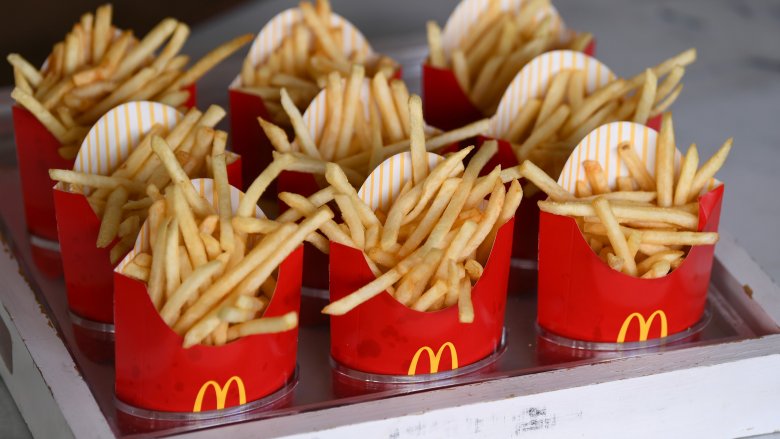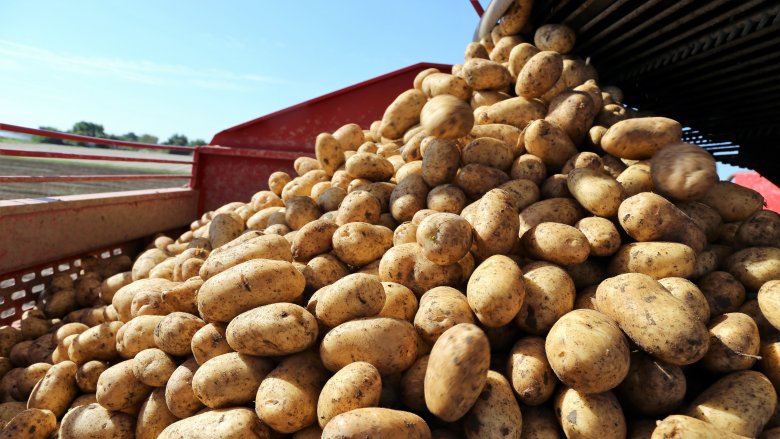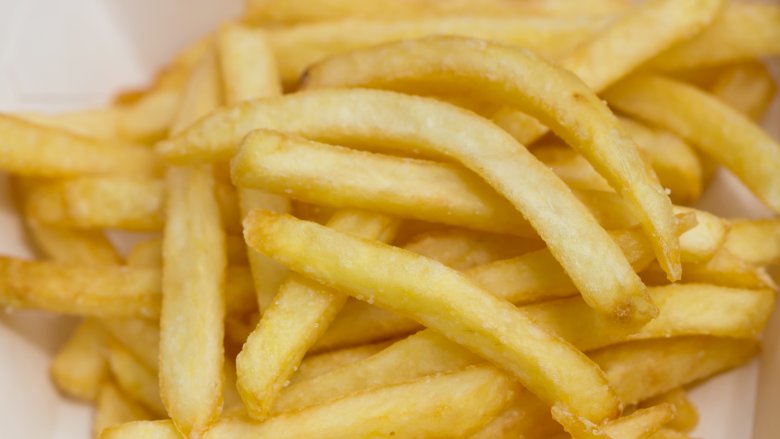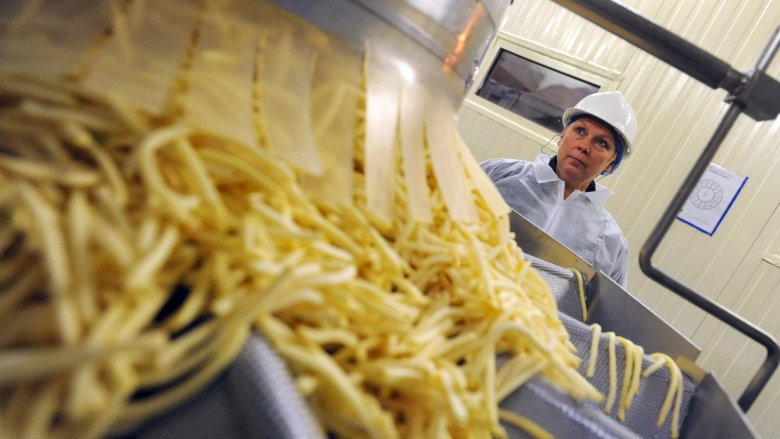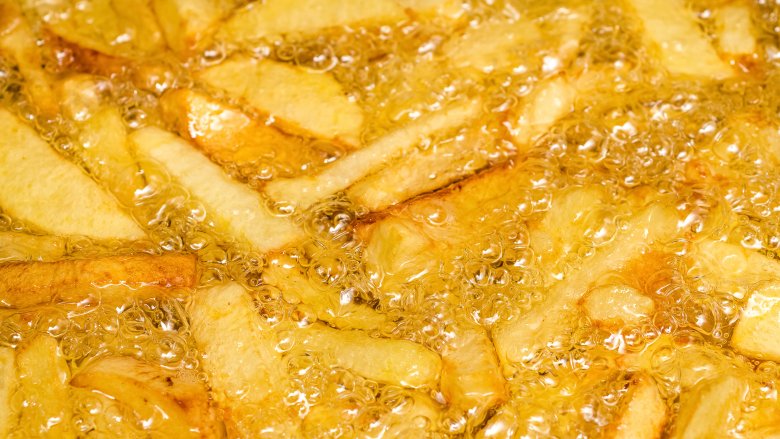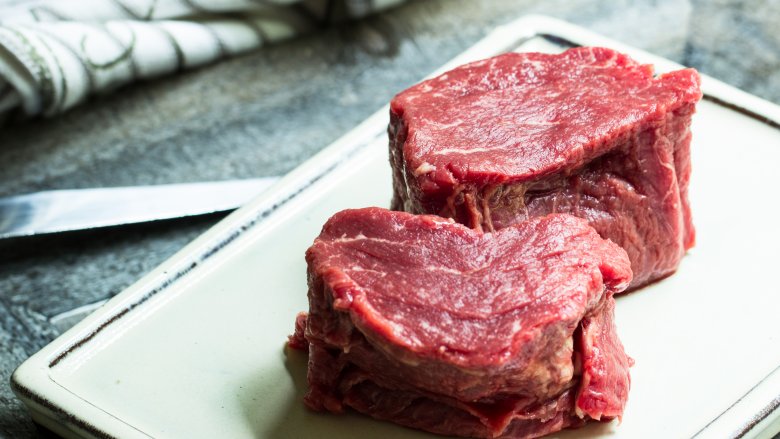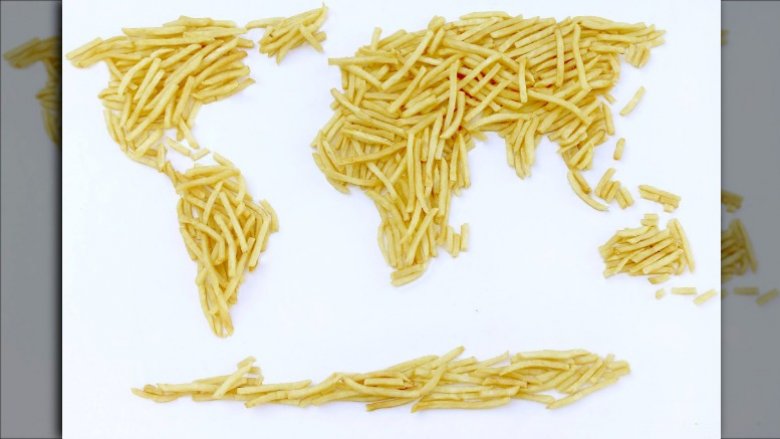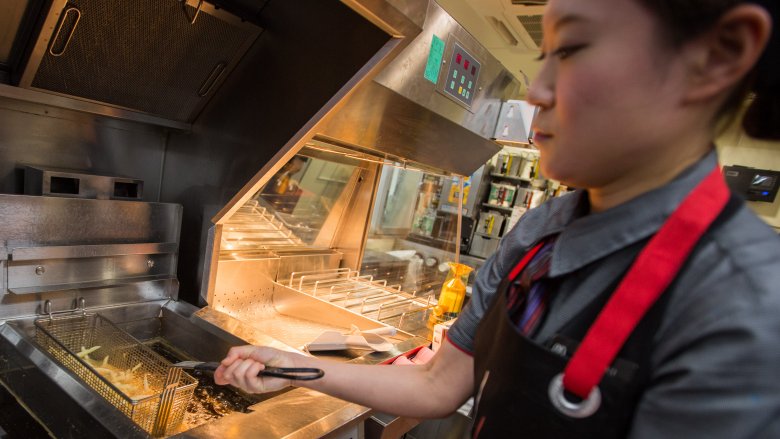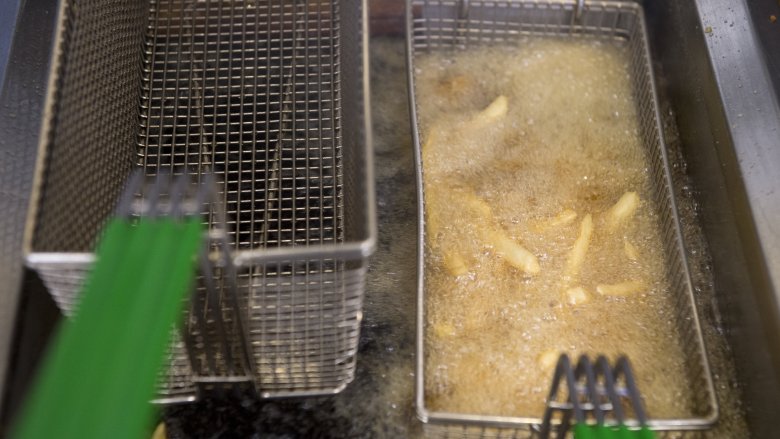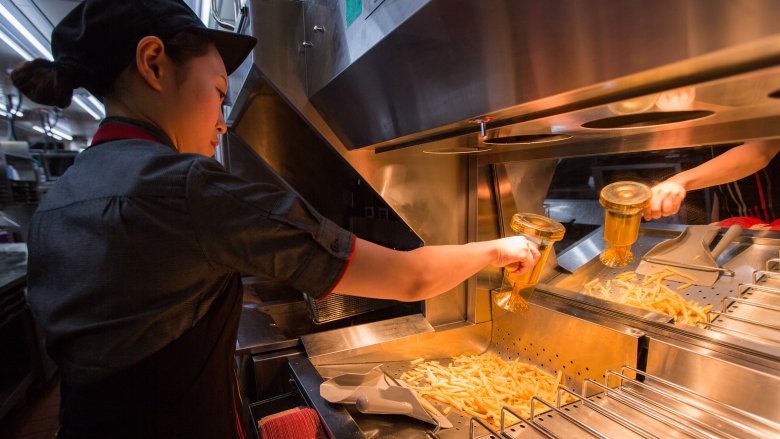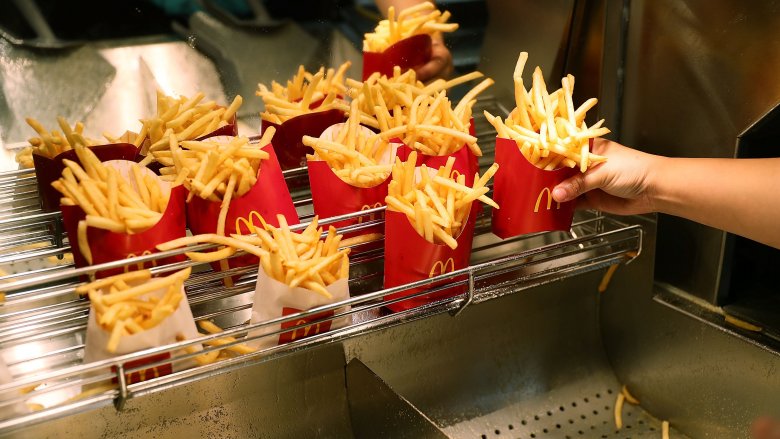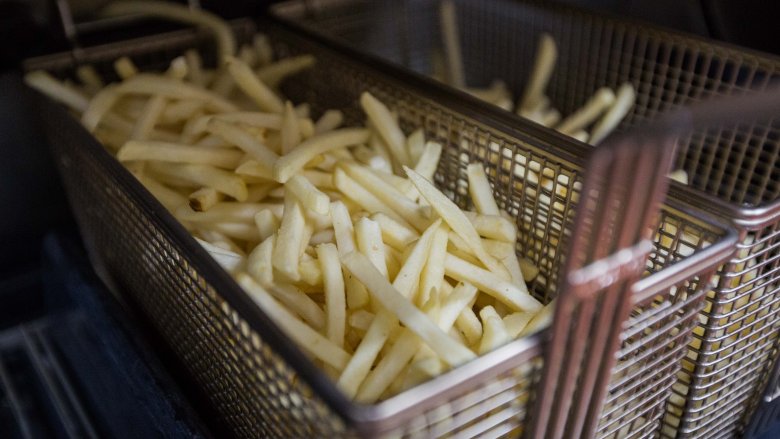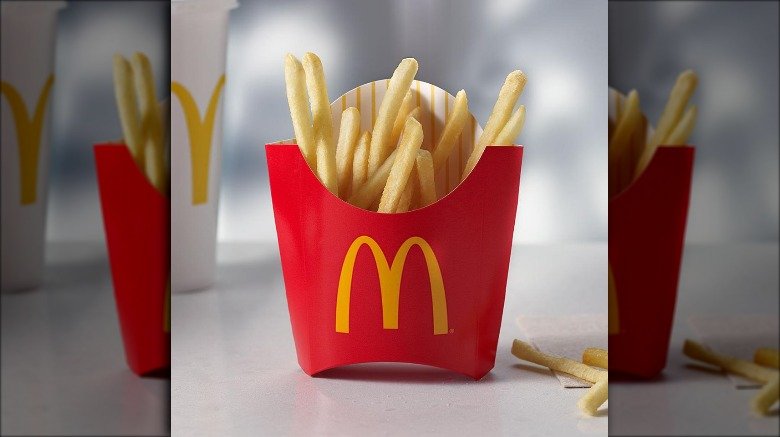This Is How McDonald's French Fries Are Really Made
There are plenty of people out there who would argue that McDonald's World Famous Fries are the best thing to come out of the golden arches. And can you blame them? Isn't there just something so special about a smiling McDonald's employee handing over that piping hot carton of golden french fries, pairing perfectly with your Big Mac on a Saturday afternoon?
McDonald's goes through close to 9 million pounds of french fries around the globe each day, so there must be something worth coming back to. Maybe it's the crispy, golden outside. Or it's the fluffy, pillowy inside you get when you bite into a fry. You know the feeling. They're the epitome of perfect french fries, known across the globe, and there's just something so delicious about them that you can't quite put your finger on. But how do they actually end up on your tray or in that drive-thru bag? Well, french fry questions no more. We decided to dive in and take a look at exactly how McDonald's french fries are made.
McDonald's actually starts with real potatoes
Much to many customers' surprise, McDonald's decided to share all about how their infamous fries are made after years of people asking if they used some sort of potato goo to get the process started. Well, no goo here. According to McDonald's, their world famous fries start with Russet Burbank or Shepody potatoes, grown from U.S. farms. Russet Burbanks, grown mostly in the Pacific Northwest, are ideal for frying and baking, making them the perfect fit for those golden fries.
The potatoes McDonald's uses are so ideal for their infamous fries that they weren't willing to stray from them a few years ago and move to another option. According to the Capital Press, J.R. Simplot engineered the "Innate" potato, offering a potato that would bruise less and produce less of a potentially cancer-causing compound when fried than conventional potatoes. But as of 2014, McDonald's had no intention of switching to the GMO product. "McDonald's USA does not source GMO potatoes nor do we have current plans to change our sourcing practice," a company spokesperson told the Capital Press. Long live the real potato!
Potatoes are peeled and cut into that infamous McDonald's shape
When it comes to fast food joints and their fries, we all have our own opinions. Some prefer Wendy's for their dipability in Frostys, while others obsess over Arby's curly fries. It's just plain preference. But we do know people love McDonald's fries. After all, going through 3.4 billion pounds of potatoes each year is not something to laugh at.
McDonald's serves up a very specific shape of fry, and that comes from the way the potatoes are cut. According to CNET, the potato-cutting machine looks like a giant wood chipper, shooting potatoes into high pressure water knives at 60-70 miles per hour.
One McDonald's factory employee on Reddit went even further to describe the machine's incredible strength, making it sound like some sort of water park attraction gone bad. "Somebody stepped in a water waste flume once and got sucked under and almost drowned. Somebody passing by had to pull him out," he said. "This wasn't a flume where fries go, but it still has water moving about the same speed... For the flumes that carry product, just imagine a few hundred pounds of fries every minute going by at lightning speed."
McDonald's fries take a chemical bath
If you look closely at McDonald's ingredient list for their fries, you'll notice quite a few hard-to-pronounce ingredients. Two of those ingredients, dextrose and sodium acid pyrophosphate, are added at the factory, essentially giving the cut potatoes a nice chemical bath.
According to Heathline, dextrose is a simple sugar made from corn, which is often used as a sweetener and can typically be found in processed foods and corn syrup. Medically, it can be used to increase a person's blood sugar. According to the Center for Science in the Public Interest, sodium acid pyrophosphate actually reduces the levels of acrylamide, a carcinogen present when potatoes are fried, so there might be some chemical additions we should be applauding.
Registered dietitian Georgie Fear told ABC that the dextrose helps the fries have a uniform golden color, and the sodium acid pyrophosphate keeps them from turning an unappealing gray color after they are cooked. Fear explained it further, saying, "Dextrose is simply a sugar that occurs naturally in our blood... To my knowledge there is no data of any health concerns from sodium acid pyrophosphate."
McDonald's fries are fried and frozen at the factory
Once the fries are cut and bathed, they're partially fried at the factory to speed up the cooking process later on once they arrive in stores. According to one McDonald's Factory employee's AMA on Reddit, the processing is all part of setting the store up for success. "Uncooked food is harder to manage bacteria growth... It's also easier if the restaurants can just reheat than actually cook," he said. It's faster for them."
According to CNBC, the fries are fried in the factory and then travel about 50 yards through a flash-freezer tunnel to complete the process, which is crucial for their uniform appearance and storage.
Potatoes aren't only at risk for turning right after they're peeled — it can also happen after they've been cooked or frozen. But thanks to the sodium acid pyrophosphate added earlier in the process, these ones they get to stay their consistently pale yellow color.
Don't forget about McDonald's beef flavoring
One of the most unique ingredients you'll see listed in McDonald's french fries ingredients is their "natural beef flavor." Yes, you read that correctly. Natural beef flavor. And we owe it to that added beef flavor for not being able to put those beautiful french fries down.
Years ago, McDonald's used to fry their french fries in beef fat, and it just became part of their signature flavor. According to NPR, the company switched to a vegetable oil base to quell concerns about saturated fat, but still incorporated essence of beef, until vegetarian groups were outraged, sueing the company for misleading their customers in thinking their french fries were actually suitable for vegetarians.
Today, McDonald's continues to mimic that flavor by incorporating their natural beef flavor containing hydrolyzed wheat and hydrolyzed milk. According to Reader's Digest, the flavoring is added to the frying oil to maintain the same beefy taste we've all come to know and love, making it safe for vegetarians, but not vegans.
McDonald's fries are distributed far and wide
When McDonald's released their story on how their fries were made, a production planner for a Simplot Factory, Koko Neher, walked us through the process, but the McDonald's and Simplot manufacturing relationship goes way further back than that. In the 1940s, Simplot created and marketed the first commercially frozen french fries and soon became the exclusive supplier of fries to McDonald's — a relationship that, according to Simplot, continues to this day.
According to Simplot's operations information, they operate potato processing plants in four U.S. cities, with three stating "The products are sold throughout the U.S. and to international customers, including regional and national quick-service restaurant chains and retail and full-line distribution companies." One can only presume the quick-service chain they're referring to is their partner Mickey D's.
Like most corporate restaurants, McDonald's employs logistics and trucking companies to deliver the food to their restaurants. One distribution center in Lebanon, Illinois, owned by Golden State Foods, services 350 stores through five states. Over all, Golden State Foods services 25,000 stores in 50 countries, and it's only one of the companies paired up with McDonald's playing a role in getting their fries to your local store.
McDonald's fries are fried again in the store
Once the boxes of McDonald's fries finally make their way to their destination, they're stored frozen until use. During service, especially during busy times, fries are made pretty much consistently. When it's time to put a fry basket down, the fries are actually designed to cook within three minutes, all thanks to the preparation beforehand in the factory. According to a McDonald's Factory employee's AMA on Reddit, the fries are actually "cooked at the factory. McDonald's basically reheats them."
At one time, McDonald's used a partially hydrogenated oil for their fries, until they completely switched over in 2008, eliminating trans fats. But the company had thought about making the switch long before 2008. According to Cargil, they spent seven years on the hunt for a replacement, testing 18 different types of oils. After years of testing, the companies ultimately decided on Clear Valley high oleic canola oil, which allowed McDonald's to fry in an oil with no trans fats and the lowest saturated fat content of any of the vegetable oils.
McDonald's adds more chemicals in-store
In 2015, when McDonald's divulged the long list of ingredients that go into making their fries, dimethylpolysiloxane was on the list. The chemical compound is not listed on the U.S. Mcdonald's ingredients list for their fries, but it is certainly present on the Canadian site.
If you want to get technical, and look at why it may not be included on the ingredient list, it's because it doesn't actually go into the fries. It's used in the cooking process. Dimethylpolysiloxane is a polymer of silcone, and according to McDonald's,it plays a huge role in their fry cooking, as it's present in their oil to prevent it from foaming and boiling over. And while it's great for preventing crew member burns, research has also found that it's the same chemical that has the potential to regrow hair. Talk about a double-whammy!
McDonald's adds very specific amount of salt to their fries
From the counter view, we as customers just a see a shaker dousing our fries in salt, but there's actually a method to the madness. According to McDonald's, they've figured out the ideal amount of salt for their fries based on their customers — and science.
In answering one of their FAQs on the McDonald's UK website asking about why McDonald's fries have so much salt on them, Mcdonald's responded by explaining, "Extensive research has shown that the majority of McDonald's consumers prefer a light sprinkling of salt on their french fries. A typical serving of a small portion of french fries contains 0.5 grams of salt."
With that standard, that puts a small order of fries serving up to 160 milligrams of sodium and large with 350 milligrams of sodium. Compared to your daily recommended amount of sodium, according to Healthline, that's not outrageous, especially when you consider that a large order of Wendy's French Fries contains 520 milligrams of sodium and an order of Burger King fries sets you back 640 milligrams. Who has salty fries now?
McDonald's fries only sit for 7 minutes, maybe
Is it even possible to drive away from the drive-thru without eating your fries on the way out of the parking lot? If you've ever let your McDonald's fries sit in their bag on the way home, you know they're not going to be as good once you dig in a few minutes later, and McDonald's knows that too.
Once fries come out of the fryer at the golden arches, there's a very specific time restriction on how long they can sit under the heat. McDonald's Canada took to their website to answer the many questions their customers have about their food, and one popular topic was how long fries sit in the heat tray before they are finally discarded.
Corporate told one enquirer, "the longest amount of time we'll keep our World Famous Fries before serving them to you is 7 minutes. (But their popularity means they're usually on your tray and in your mouth much faster than that.)"
But the real question is whether corporate standards for freshness are adhered to in every single store across the globe. According to a McDonald's employee on Reddit, the fries can sit no longer than 15 minutes, but that is not strictly enforced.
But if you truly want fresh McDonald's fries, just ask
Despite the corporate standards, we all know fries have the potential for sitting for quite a while. In recent years, McDonald's aficionados realized they could ask for salt-free fries and the employees would have to make a fresh, piping hot batch.
According to one McDonald's employee on Reddit, "when people ask for no salt we have to put a new batch down to ensure it hasn't touched any salt at all." But as fry lovers began to abuse that privilege, using the method for fresh fries and then just adding salt packets, McDonald's employees began to speak out.
According to another crew member on Reddit, all you need to do for fresh fries is ask. "Did you know that you can simply ask for fresh fries if that's what you wanted?" the employee said. "They'll actually most likely be newer than asking for no salt!" But if you do ask for fresh fries, be sure to remember they will take a few more minutes than normal. One employee told Reddit it takes about 3 ½ minutes to complete the order.
Finally, McDonald's fries are served up in that classic container
Last but not least, those crispy, hot golden fries make their way into that infamous red and gold container. But how many fries are you actually getting in your order? According to one Mcdonald's employee on Reddit, you may not be getting as many fries in your Large Fry as you think, even though it may appear to be filled to the brim.
"I worked at McDonald's and they taught me how to pinch the fry carton just right while putting the fries into them so that it looks full, but actually wasn't," he said. "I only had one customer called me out on it. He shook the fries out into his bag and poured them back into the fry carton himself and it only filled up halfway,"
A McDonald's spokesperson came forward and told Daily Mail these claims aren't true, stating "there are no 'secret tricks' and we have strict operation procedures in place to ensure that fry portions are not under-filled." But with a number of employees coming forward, it makes one wonder how many fries you really are receiving once your fries are places on your tray.
